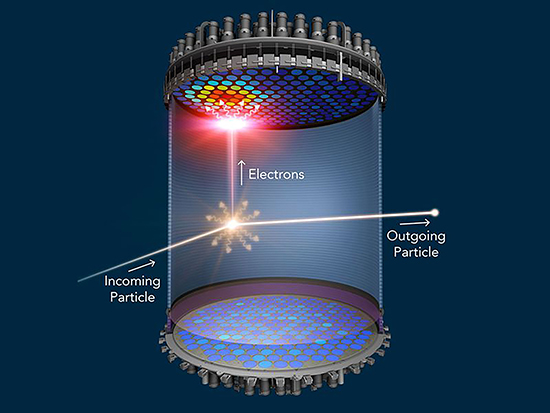Mystery Signal in Recent Dark Matter Search Potentially Explainable by Known Physics
 |
|
The best way to look for dark matter right now is with liquid Xenon detectors, a technology that is so advanced that there are multiple versions of it globally.
|
ALBANY, N.Y. (Aug. 18, 2020) – A recent publication on potential new physics signals observed by the XENON1T dark matter experiment which was detailed in The New York Times can also be explained by known physics, according to UAlbany physicists.
The XENON1T project, operated at the Italian Gran Sasso National Laboratory, utilizes a liquid-xenon time projection chamber to search for Weakly Interacting Massive Particle (WIMP) dark matter as well as axions and other potential new particles. In a recent paper, “Observation of Excess Electronic Recoil Events in XENON1T,” the collaboration discovered low-energy signals that could potentially provide evidence of dark matter, the theorized particles that are believed to comprise as much as 85 percent of the matter in the universe, or more likely solar axions, another type of exotic particle, in this case coming from the Sun.
Utilizing the Noble Element Simulation Technique (NEST) software to simulate the XENON1T detector, UAlbany physicists Matthew Szydagis, Cecilia Levy, their postdoctoral associates and students recreated the conditions described in the XENON1T paper. According to their findings, the excess signals are more likely explained by known particles, and can be shown to agree better with the data presented.
 |
|
Assistant professors of physics Cecilia Levy and Matthew Szydagis
|
Entitled “Investigating the XENON1T Low-Energy Electronic Recoil Excess Using NEST,” Szydagis and Levy have shared their findings on ArXiv, an open-access archive for articles in the fields of physics, mathematics, computer science, and similar scientific fields. They have also submitted their manuscript to a leading scientific journal for peer review.
“The search for dark matter, the missing mass of the un¬iverse, is one of the most active fields of study within particle physics,” said Levy and Szydagis, assistant professors of physics at UAlbany. “While the XENON1T experiment recently observed an excess signal potentially consistent with dark matter or solar axions, we found that by utilizing the NEST software we can reproduce the excess in multiple, unique ways, but using known physics.”
“Using NEST, we showed that Argon-37, which is present in the air, is not an unreasonable explanation for the excess,” said Levy, an assistant professor of physics at UAlbany. “This is independent confirmation the excess is a real effect, but potentially explicable by known phenomena.”
Szydagis and Levy conducted numerous cross-checks of their hypothesis. In their analysis, the excess signal events were shown to be statistically consistent with Argon. This likely indicates that XENON1T, which did consider more mundane explanations such as tritium, but not argon as deeply, has probably not found evidence of dark matter, nor of axions.
While both axions and dark matter remain elusive and searches for them continue, they remain critical puzzles, the answers to which would advance humanity’s understanding of the universe.
“What’s very interesting about the search for dark matter is that it's backwards: we know how it holds the universe together, but have no evidence for what it actually is,” continued Szydagis. “As for the axion particle, it could be the dark matter under the right conditions of mass, but may be entirely unrelated, as it comes from solving a different mathematical puzzle.”
This is one reason why dark matter experiments across the globe hunt for various potential candidates, from WIMPs to axions. Szydagis and Levy agree that the best way to look for dark matter right now is with liquid Xenon detectors, a technology that is so advanced that there are multiple versions of it globally, such as XENON1T/nT and LUX-ZEPLIN, which Levy and Szydagis work on, as well as PandaX.
![]() For more news, subscribe to UAlbany's RSS headline feeds
For more news, subscribe to UAlbany's RSS headline feeds
A comprehensive public research university, the University at Albany-SUNY offers more than 120 undergraduate majors and minors and 125 master's, doctoral and graduate certificate programs. UAlbany is a leader among all New York State colleges and universities in such diverse fields as atmospheric and environmental sciences, business, education, public health,health sciences, criminal justice, emergency preparedness, engineering and applied sciences, informatics, public administration, social welfare and sociology, taught by an extensive roster of faculty experts. It also offers expanded academic and research opportunities for students through an affiliation with Albany Law School. With a curriculum enhanced by 600 study-abroad opportunities, UAlbany launches great careers.


